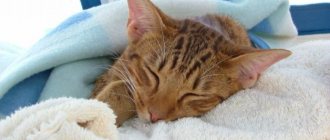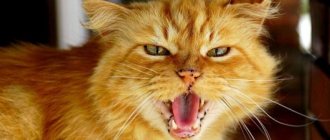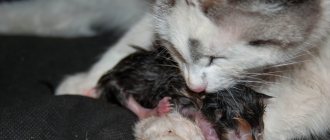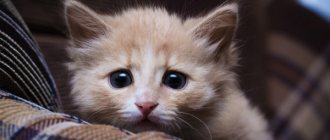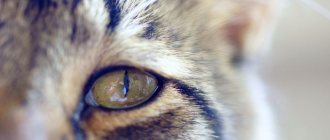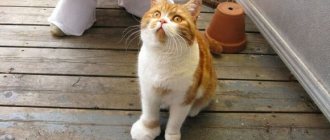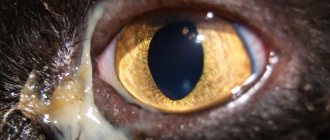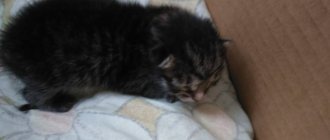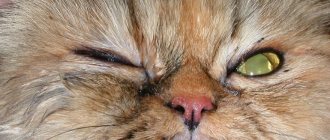Screams, caresses and other manifestations of sexual desire in a cat are a physiological norm. A pet has always been a canon and a symbol of comfort. When choosing a pet, the owner relies on his own preferences. Some people love fluffy cats, while others, on the contrary, adore smooth-haired and short-haired mustaches.
They look different, each has its own characteristics and character. But the only thing that unites all cats is sexual hunting. The appearance of estrus, especially at the beginning of spring, does not go unnoticed not only by cat owners, but also by people who do not have pets at home. The cries of females and males, showing readiness for mating and further procreation, can be heard tens of meters away.
It is important to understand that such behavior for a pet, such as rolling on the floor, increased love of love or aggressiveness during sexual desire, is a physiological norm. This is not a pathology, but only a signal from the pet’s body that it is fully mature and ready for procreation.
Owners of young cats should know how to recognize a cat's first heat and prevent fertilization. In what cases should you sound the alarm and contact a veterinarian, and you also need to know how to alleviate the animal’s suffering and possible solutions to the problem.
At what age should you expect your first heat?
Pets are all unique individuals, so when a cat goes into first estrus varies from person to person. The onset of estrus depends on a whole range of factors, such as the health of the young cat, its individual size, breed, time of year and hormonal status (temperamental or non-temperamental cat).
The average indicator for the onset of sexual heat in an animal is a period from 7 to 11 months. In rare cases, age up to 12 months is considered normal. If there is no onset of the sexual cycle (estrus) in cats aged 12 months or older, it is recommended to consult a specialist about the abnormality.
The cause of delayed maturation in the genital area in cats can be a wide variety of pathologies of the genital area - hormonal imbalances and malignant tumor processes.
Estrus manifests itself in different ways, just as the interval between cycles varies for each individual animal. It is physiologically determined that each sexual cycle lasts from 2-3 weeks to 6 months and ends with fertilization, with further gestation of kittens. The cat’s body takes from 2 to 2.5 months to bear kittens, followed by the period of lactation and motherhood.
In the absence of fertilization in domestic cats, the cycle is shortened, so sexual heat occurs more often. Scientists also note that the duration of periods of direct sexual heat is indirectly affected by the length of daylight hours in wild cats. This feature is not noted in domestic animals.
Pregnancy after laparoscopy and hysteroscopy
Many patients, after combined endoscopic surgery - laparoscopy and hysteroscopy, worry about the possibility of becoming pregnant. Doctors reassure: there is no need to worry too much, since both methods in most cases only contribute to pregnancy, as they help to detect and eliminate serious problems that lead to infertility. Laparoscopy with hysteroscopy is performed for diagnostic and therapeutic purposes. Such methods of intervention are especially recommended for infertility of unknown origin, when other studies do not allow us to establish a clear reason that a woman cannot become pregnant.
When can you start planning after such a complex procedure?
After the operation, it is necessary to take a break from sexual relations for about 3-4 weeks. Further, sexual intercourse with the use of contraceptives is allowed. Unless the attending doctor thinks otherwise, most operated women are allowed to become pregnant 2-3 months after the intervention.
How to find out when estrus begins
Characteristic signs will help the owner understand that a cat is in heat. By carefully observing his pets, the owner can easily determine the onset of sexual heat by the following signs:
- the visible reproductive organs of the animal (loop or vulva) become swollen, mucous discharge may appear, but not in abundance (there should be no bloody drops when a pet is in heat, unlike in a dog in heat);
- the pet becomes more clean and carefully monitors the cleanliness of the genitals;
- acts of urination occur more often, the cat may shit during estrus, due to blood-filled genitals, pressing the intestines from the inside;
- the animal refuses to eat, a distortion of appetite is possible;
- changes in behavior - the pet shows maximum affection, rubs against the owner, furniture and clothes;
- a cat marks its territory during estrus, indicating to males that it is ready for mating and procreation;
- manifestation of aggression (occurs rarely, but is sometimes observed in cats);
- there is a desire to run away from the house (the animal tries to jump out of a window, balcony or slip through the door);
- plaintive sounds appear, the cat screams and meows, indicating its location to the opposite sex;
- the pet arches its back, sticks out its butt invitingly, can stomp on its paws and move its tail to one side.
The fact that a cat marks its territory during estrus is one of the most unpleasant phenomena for the owner of the cat’s sexual heat. It is important to understand what stages of estrus exist in order to monitor the animal more closely. This will allow the owner to more clearly understand what the animal feels during each period and how to help it.
Stages of estrus in cats
Estrus in a cat, or scientifically known as estrus, is a physiological process necessary for further procreation. Sexual desire in cats is divided into four categories: preliminary, estrus, metestrus, and end of the cycle.
The preliminary period - proestrus is characterized by an increase in the size of the follicles located in the ovaries. They contain a mature egg. During proestrus, there is an increased production of the female hormone estrogen.
The cat at this stage is not ready to mate and become fertilized, but the owner may notice changes in the behavior of the pet. The animal becomes more demanding, wants more attention, appetite decreases, and it can damage furniture. There is pronounced swelling in the area of the external genitalia, and mucous discharge appears. The duration of this stage is from 2 to 4 days. After it comes the estrus itself.
Estrus, or true estrus, is the stage most suitable for fertilization of an egg by a sperm. This period is characterized by increased cat activity. She screams invitingly and waits for the male, behaves strangely indoors, crouching to the floor, raising her butt, can swing it from side to side, and bends her tail.
Depending on the character of the animal, signs of true estrus may vary. Thus, more temperamental females become aggressive and excessively noisy, but calmer females will not be so eager to leave the house, but will still annoy the owner with their behavior. The duration of true estrus in cats varies from person to person, but on average ranges from a week to 14 days.
The third period of estrus in a cat is metestrus, which is a decline in sexual desire, the behavior of the pet changes dramatically. Instead of affection and screams, aggression towards males occurs. An unfertilized female becomes calmer, and in the case of fertilization, the animal prepares for the upcoming pregnancy.
In some cases, metestrus without fertilization turns into a pathological state such as false pregnancy. This phenomenon is extremely similar to normal pregnancy - the female builds a nest for the “future” offspring, the mammary glands swell, and colostrum is released.
This condition is dangerous for the animal, as it can provoke a serious hormonal imbalance in the body and requires corrective treatment under the supervision of a veterinarian.
The fourth period is anestrus, characterized by the end of the sexual heat cycle. The cat becomes calm and balanced. Under normal conditions, estrus in a cat is a physiological process and does not require any outside intervention from the owner in the form of injections and tablets. It is necessary to show maximum attention to the animal, in no case scolding, and also without locking it in the room. The use of physical force is prohibited, as it can provoke serious psychological trauma in the animal.
Natural food products
Products are chosen fresh, rich in proteins, calcium, carbohydrates and beneficial elements.
Among them:
- boiled lean meat: chicken, beef, rabbit, turkey, veal;
- vegetables: beets, pumpkin, cauliflower, carrots, zucchini;
- cottage cheese, curdled milk, natural yoghurts, biokefir;
- cereals: buckwheat, oatmeal, sprouted wheat grains.
To reduce the risk of developing constipation due to intestinal problems, add to the main diet:
- low-fat broths in which meat was cooked;
- warm milk (in small quantities);
- 3 – 4 drops of flaxseed, olive, sesame oil (added to food);
- boiled beets or puree from them;
- young shoots of oats, wheat, barley.
Approximate diet
In the second week of pregnancy, the cat’s appetite increases, therefore the amount of food is increased by 10% of the previous volume, from the second month - by 50%. In the last weeks before childbirth, appetite decreases, it is recommended to reduce portions, and the number of feedings is calculated based on the needs of the expectant mother. An adult animal needs 180-200 grams per day to be satisfied.
How to calm a cat during heat
If the owner of a domestic cat does not want to receive offspring from his mustachioed pet in the future, then doctors recommend early sterilization. The use of surgical intervention allows not only to completely calm the cat during heat, but also to prevent further manifestations of anxiety in the animal.
As a rule, an operation is performed to remove the reproductive organs after the female’s body has formed in all respects, but before the onset of estrus. Until now, veterinary specialists cannot come to a consensus on what age is most optimal for sterilization.
Before deciding to spay or neuter, it is necessary to accurately diagnose your pet's body and consult with a qualified veterinarian.
Sterilization, which has a number of positive aspects, will help stop a cat's heat. First of all, this is a health benefit, since cats that have been sterilized in a timely manner will not develop malignant neoplasms of the mammary glands. The likelihood of developing pathological processes in the genital area in a cat is reduced significantly.
In addition, the animal becomes much calmer, which is caused by changes in hormonal levels. There are also side effects associated with castration of a cat - changes in metabolism. Quite often, females gain excess weight as a result of hormonal changes. This can be avoided if you carefully select the animal’s diet.
Rarely, there are risks associated with an animal coming out of anesthesia after surgery. Complications arise when the drugs are chosen incorrectly, as well as in the presence of chronic diseases of the cardiovascular system.
You can help a cat in heat for a short time by using various hormonal and herbal medications. Plant-based drops for cats are widely used directly during estrus. They do not have a harmful effect on the animal’s body and do not provoke serious complications with long-term use.
These medicinal sedatives for cats based on herbs - Kot Bayun, Stop-stress, can be used not only for females during estrus, but also for males who are actively experiencing the period of sexual heat with nearby females.
In order to facilitate estrus, special hormonal-based products are used, but only after consultation with a veterinarian and the exact dosage indicated. Drops for cats during estrus and tablets such as Countersex, Gestrenol, Perlutex, as well as Covinan and Depo-Provera injections should be used with great caution.
Hormonal drugs have a number of side effects, especially with regular use. At home, hormonal medications should be used as rarely as possible. It is advisable to consult a doctor and undergo surgery to remove the reproductive organs.
Cats used for breeding that have breeding value should be seen by a veterinarian. In order to alleviate the cat's condition, it is necessary to give herbal sedatives, and special panties for cats will help prevent unwanted fertilization.
A short checklist: a list of recommendations after tooth extraction
What can and should be done
- hold the cotton swab applied by the doctor for 20-30 minutes,
- within 2-3 hours after surgery, be sure to apply cold compresses to reduce tissue swelling,
- carry out oral baths (not to be confused with rinsing) with antiseptic drugs for 3-5 days: “Miramistin”, “Chlorhexidine 0.5%” or other drugs prescribed by a doctor can be used as medicinal solutions,
- after 3-5 days, start using a toothbrush - only a soft one for the operated area, as well as a new one, without bacteria on it. The teeth of the opposite jaw can be brushed immediately, the main thing is to avoid the area of the extracted tooth,
- chew food on the side opposite the injured area,
- You can drink water immediately, preferably warm water,
- You can eat only after the anesthesia wears off, that is, after 2-3 hours,
- Lead a quiet lifestyle, try to avoid physical activity and heavy lifting for 5-7 days.
What you should absolutely not do
- don't rinse your mouth! Mouth baths in the first 3-5 days are more than enough,
- do not use hot compresses! This is fraught with the appearance of edema and the development of inflammation,
- do not create a vacuum in your mouth: do not puff out your cheeks, sneeze, blow your nose and spit very carefully,
- do not pick the wound, do not touch the clot with your tongue,
- do not drink or eat hot or cold food, only warm food,
- try to quit smoking for at least 2-3 days after surgery,
- Do not drink alcohol for 2-3 days - it does not promote tissue repair. Also exclude it if the doctor has prescribed a course of antibiotics,
- Do not overcool or overheat - give up sports exercises, swimming pools, saunas for 5-7 days.
A sterilized cat is in heat
The onset of estrus in cats is triggered by the work of the ovaries and the hormonal substances they produce. It is important to understand that sterilization is actually a procedure that involves tightening the fallopian tubes or removing the uterus without the ovaries. Carrying out castration allows you to get rid of sexual desire in a cat.
In some cases, after surgery to remove the reproductive organs, the animal remains with characteristic signs of sexual heat.
The main reasons why a cat behaves the same as before during estrus are:
- Slow attenuation of the production of sex hormones . After manipulation to remove the reproductive organs, sex hormonal substances do not disappear, but continue to move through the bloodstream for some period. As a rule, complete attenuation of hormonal levels occurs after 1.5 - 2 months. Less often, a long process of attenuation is recorded.
- Ovarioreminant syndrome . If the animal was castrated after the first heat, or even less often, after the first birth, there is a high probability of developing preserved ovarian tissue syndrome. Any tissue structure in the body is capable of reproducing from small particles through division. The remaining piece of ovarian tissue is able to grow over time and produce hormones (less commonly, mature eggs).
More rare causes of estrus in a cat after sterilization are:
- Ectopic tissue syndrome is a rare congenital anomaly. With this pathology, ovarian tissue can be located in any part of the body. Diagnosing the pathology is quite problematic, since it can be located in any part of the peritoneum.
- Tumor process . A neoplasm located in the mammary glands, adrenal glands, hypothalamic-pituitary system or uterus is hormone-producing. The development of sexual heat in such cases is taken over by the adrenal glands or the pituitary gland.
Only a qualified veterinarian can determine the exact cause of estrus in a sterilized cat, based on laboratory tests. Blood is drawn for a hormonal panel. The level of the female hormone estradiol is determined by cytological analysis.
Is it possible to spay a cat during heat?
Carrying out a hysterectomy operation (removal of the uterus and ovaries) is a fairly radical measure. After the pet is sterilized, sexual hunting subsides and neither the animal nor the owner is bothered anymore. It is recommended to perform surgery in cats that are physiologically mature before the onset of their first heat.
It happens that the cat owner wants to undergo surgery during the period of estrus or the period of gestation of kittens in order to terminate the pregnancy. The decision is quite dangerous for the life of the pet, so veterinary experts recommend waiting until the end of estrus or pregnancy. The risk of complications is associated with large blood losses, difficult recovery from anesthesia, as well as hormonal fluctuations.
If the owner insists on undergoing surgery during estrus, veterinarians offer the most gentle method of sterilization - laparoscopy. This is a minimally invasive procedure that is performed fairly quickly. An incision is made on the cat's belly and manipulation is performed. The duration of the laparoscopic method is from 15 to 20 minutes.
Medicines after tooth extraction: what to take at home
To prevent complications, your doctor will prescribe home remedies for you. Which medications you can take depends on your specific situation, body characteristics, allergic reactions and possible concomitant diseases.
How to reduce pain after tooth extraction
Your doctor will recommend the medications to you. You should take painkillers as needed - at night or when the anesthesia wears off. If the pain becomes severe in the first days, you can take analgesics prescribed by your doctor every 4-6 hours, but no more than 4 days in a row.
Important! Do not take aspirin or other blood thinners.
What antibiotics should you take?
Antibacterial drugs are needed if the immune system itself cannot cope with pathogenic microbes, and infectious inflammation begins. But antibiotics suppress the activity of “good” microorganisms and also have many side effects. Therefore, they are prescribed strictly based on health conditions at the time of tooth extraction and how the operation went. As a rule, they are necessary if there is concomitant inflammation in the oral cavity, an infectious process in the acute stage in the body as a whole, or if a large number of teeth were removed at once.
When receiving a further treatment plan, you need to purchase medications immediately, without delay, so that you can help yourself in case of increased pain and discomfort. The doctor’s recommendations must be strictly followed, avoiding “amateur activities.”
Therapeutic oral baths during tissue restoration
Intense rinsing is prohibited - this way the solution can wash out the blood clot and expose the socket, causing the tissue to become inflamed and difficult to heal. Rinses are replaced with medicinal baths. For this, both plain water and antiseptics prescribed by the attending physician are suitable: a solution of “Chlorhexidine” 0.05% (in this concentration it is sold in a pharmacy) or “Miramistin” you just need to hold it in your mouth for about 30-60 seconds, and then spit it out. You need to repeat the procedure after meals, 3 times a day.
Such baths will become a mandatory component of the prevention of inflammation if you have the following problems in the oral cavity:
- other teeth are damaged by caries or have tartar on them. Pathogenic microorganisms in sediments can lead to the development of alveolitis,
- cuts were made on the gums to expose the gumboil,
- under the extracted tooth or the tissue nearby was inflamed.
Rehabilitation without complications! We use modern equipment and materials to ensure that even complex tooth extractions are carried out with minimal trauma.
Enroll now
